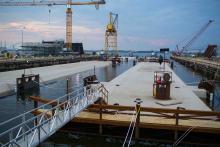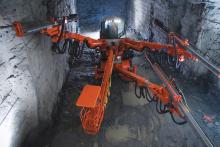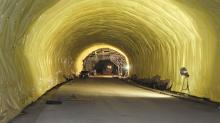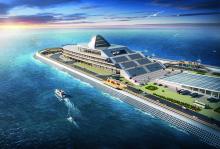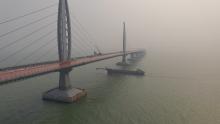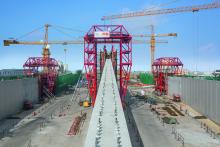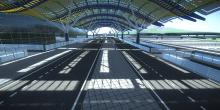A project to construct the second Midtown Tunnel link in the US state of Virginia alongside the original connection has taken an important step forward – Mike Woof writes
Commuters in the US state of Virginia will be pleased that the new Midtown Tunnel is now open to traffic, as it will help to boost capacity and cut congestion on the busy US 58 route connecting Norfolk and Portsmouth. The 1.13km tunnel link has been built to link with the interchange at Brambleton Avenue and Hampton Boulevard in Norfolk
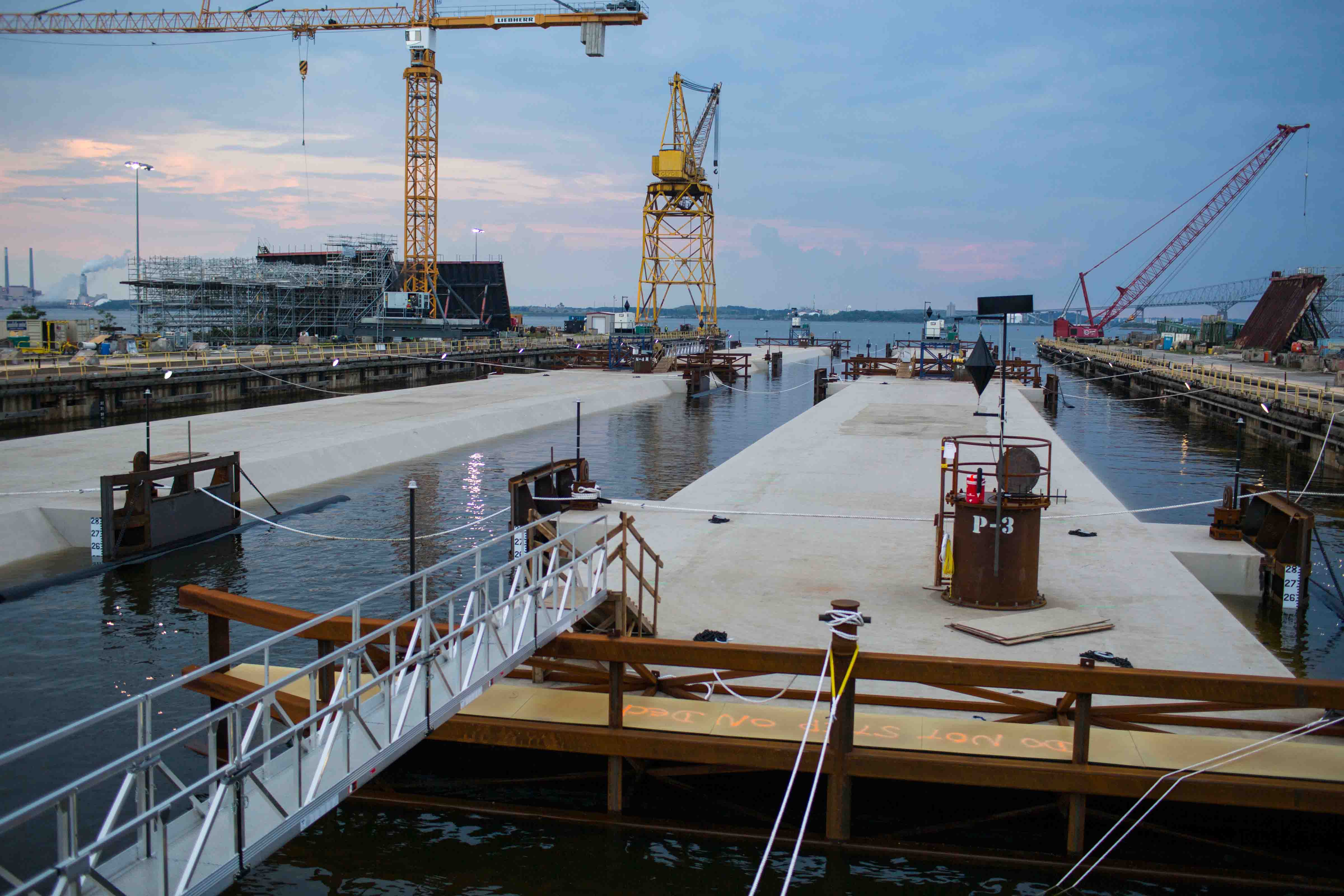
Once they were ready, the sections were moved out from the fabrication yard. Image courtesy of Stirling Lloyd
A project to construct the second Midtown Tunnel link in the US state of Virginia alongside the original connection has taken an important step forward – Mike Woof writes
Commuters in the US state of Virginia will be pleased that the new Midtown Tunnel is now open to traffic, as it will help to boost capacity and cut congestion on the busy US 58 route connecting Norfolk and Portsmouth. The 1.13km tunnel link has been built to link with the interchange at Brambleton Avenue and Hampton Boulevard in Norfolk and when the project is complete, journey times will be significantly reduced.
Constructing the new tunnel, an immersed tube, proved challenging due to the high density of existing structures on either side of the channel, which limited the space available for the project team. An additional challenge came from a need to move existing infrastructure to allow the project to be carried out.
The two-lane, tolled tunnel runs under the Elizabeth River, providing increased capacity for both the US Route 58 and nearby I-264 in Portsmouth. The Elizabeth River is a tidal estuary, forming part of the Hampton Roads harbour in south-east Virginia. The project team had to take account of the fact that the Elizabeth River carries a steady volume of waterborne traffic as the Norfolk Navy Shipyard is close at hand, while the river also provides a connecting link to the south for the Atlantic Intracoastal Waterway. The sheltered waterway runs to Florida and handles vessels for both commercial and recreational purposes.
This is a $2.1 billion project and has been delivered through a design, build, finance, operate, and maintain (DBFOM) concession package. This cost covers the construction, operations and maintenance, interest, reserves, insurance, and development of the project. The Elizabeth River Tunnels Project (ERTP) was developed by the5131 Virginia Department of Transportation (VDOT) in partnership with Elizabeth River Crossings (ERC). Meanwhile, the Commonwealth of Virginia is the owner of the project with ERC having responsibility for the operation and maintenance of the Midtown and Downtown tunnels. SKW Constructors, a joint venture between 2296 Skanska, Kiewit and 1375 Weeks Marine, has taken the role of design-build contractor. SKW Constructors awarded the horizontal directional drilling work to the Michigan-based Mears Group because the contractor is a recognised world leader in the field of horizontal directional digging (HDD).
The need for the new tunnel had become acute in recent years as the original tunnel was unable to cope with demand. The first Midtown Tunnel opened to traffic in 1962 but the local population in the area has increased by nearly 70% since that time. Meanwhile the volume of traffic had climbed from 8,400 vehicles/day to 38,000 vehicles/day. It was well beyond its design capacity and in addition to the congestion issues afflicting traffic in the immediate area, there were also growing concerns over the safety of the link. Congestion was particularly bad in summer months, when the area has additional traffic due to tourists using the link to access the nearby Virginia Beach.
The second tunnel has now been constructed alongside the existing tunnel and the original link is now being refurbished. When the work to improve and upgrade the first tunnel is complete in 2018, the two-way traffic flow will start. Ensuring that both tunnels only carry traffic travelling in the same direction instead of the two-way traffic in the existing Midtown Tunnel will boost safety and eliminate the risk of head-on crashes.
Building the new immersed tunnel has been an impressive project, providing major engineering challenges for the team involved. The shortage of space close to the site meant that constructing the 11 precast segments for the immersed tube tunnel had to be carried out some distance away.
The lack of a suitably large drydock close to the construction site was one of many challenges. It meant that these concrete segments, weighing around 13,000tonnes each and measuring 106m long by 16m wide and 8.8m high, had to be built at a facility far upriver in Sparrows Point, Maryland. Fabrication for the segments commenced in November 2012 with formwork from203 Doka playing a key role during the construction of each section.
SKW Constructors opted to use the SL-1 supporting system from Doka, as this is a heavy-duty solution that is designed for high loads. According to Doka, the modular SL-1 system provides a strong, torsion-proof sub-construction for the tunnel formwork. This formwork system is said to speed construction work and offers extra stability that allows only minimal deformation, as well as having the ability to be readjusted in any direction due to fine pitch screw-threads.
Meanwhile the tunnel formwork traveller is said to have allowed short set-up times, due to pre-assembly of the formwork and the heavy-duty SL-1 components, as well as minimal repositioning times due to the all-hydraulic rail guidance.
And to ensure that the segments would be waterproof, the Integritank membrane from2314 Stirling Lloyd was selected as a lining system. This proven technology has been used successfully on several major immersed tube tunnel projects in Hong Kong, Mexico and the Middle East.
The original plan for the project, however, was to use crackproof concrete instead of a waterproofing membrane, but it was realised that this would not offer the same level of waterproofing. Instead, Integritank was specified as part of a long-term asset plan, to lengthen the working life of the tunnel.
A total of 33,500m2 of Integritank membrane was spray applied to a thickness of 2mm in two layers. A number of quality assurance tests were carried out, including checking the wet film thickness every 10m2 to ensure a minimum 1mm in wet film thickness for each of the two coats applied. The waterproofing system was designed so that it would be extremely durable and would also offer a very long working life. The specification required that the waterproofing system should also last longer than the design life of the tunnel.
Further tests were carried out to check that the adhesion to substrate every 500m2 was in order, to achieve a minimum adhesion of the membrane value of 0.7 MPa. Actual adhesion values on the project were far in excess of this requirement. Consumption rate checks also ensured adequate quantity of material had been installed for each phase of work. Once Integritank had been applied to the external walls and roof of the tunnel, the dry dock was flooded and the tunnel elements immersed, to confirm they were completely watertight. And despite the scale of the project and the poor weather conditions during the winter period, the waterproofing of the sections was carried out successfully, both on time and within budget.
Once they had been completed and tested successfully, the segments were loaded onto a barge and towed around 350km from Chesapeake Bay to Virginia. Their size meant that the sections had to be transported in two loads, of six and five units each.
Meanwhile at the site, preparation for the installation of the sections was underway. Nearly 1 million m3 of spoil had to be excavated from the bed of the Elizabeth River to make way for the immersed tunnel, with the team effectively digging a trench underwater across the channel. Once the trench had been excavated, the engineering team then placed around 40,000tonnes of aggregates in this trench, to provide a secure base for each of the segments.
When the precast sections arrived by barge at the site they were unloaded and positioned carefully in the river. Each of the sections was sunk into place by adding concrete ballast blocks, pumping in concrete and flooding the ballast tanks with over 15 million litres of water. The productivity rate for this stage of the operation was comparatively high, despite the busy site location and the challenges imposed by the weather, with the 11 sections being lowered at a rate roughly of one/month.
Despite the massive size weight of each segment, these sections were positioned with a high degree of precision, to an accuracy of +/– 25mm. The sections were joined with rubber seals and this tunnel is of note as it features a special watertight concrete, making it only the second tunnel in the US not to require an external steel skin. With the sections in place, another 675,000tonnes of backfill was then placed over the immersed tunnel. As the Elizabeth River does carry substantial volumes of waterborne traffic, it was realised that the immersed tube would have to be adequately protected from any possible damage. To achieve this an additional 68,000tonnes of rock armour was placed on top to ensure that the tunnel could not be damaged by ship anchors for example.
Now that the link is in use, ERC will run the concession package for a 58-year period. Meanwhile ERC comprises Skanska Infrastructure Development and2378 Macquarie Group and the existing Midtown and Downtown Tunnels are being tolled so as to help finance the project.
The first key stage of the project is now complete, with the new tunnel now carrying traffic. But with it now in use, work is underway at present to refurbish the old tunnel and bring it up to modern safety standards with regard to issues such as lighting. When work is complete in mid-2018, the existing Midtown Tunnel will handle one-way traffic travelling eastbound from Portsmouth to Norfolk. Meanwhile the new tunnel will carry westbound traffic from Norfolk to Portsmouth, with the project providing a quicker and safer route for drivers.
Planning and financing
The need to increase capacity at this location had been well-known for some years as the increase in traffic had been well documented. But decisions had to be made on the necessary funding methods to provide a new tunnel link. A feasibility study was carried out for the Hampton Roads Metropolitan Planning Organization (MPO) in 2006.
The study evaluated the potential for using toll financing to support transportation projects in the area, including the construction of the Midtown Tunnel. The results of this study showed that a new tunnel could be constructed alongside the existing Midtown Tunnel as long as it was funded by tolls. However the study also showed that tolls would have to be introduced to the nearby Downton Tunnel as well, or drivers might try to divert through this route instead, causing congestion.
In 2011 VDOT awarded the contract to Elizabeth River Crossings (ERC) to construct the new tunnel. The package of works also included improving the existing Midtown Tunnel as well as the Downtown Tunnel, while the deal also incorporated an extension to the Martin Luther King Freeway. The arrangement of the contract meant that VDOT retained ownership of the tunnels and would also oversee the operation of the links. But the financing, construction, operation and maintenance for the tunnels would be handled by ERC under a 58-year concession agreement.
In addition, ERC was also to carry the risk to deliver the project on a performance-based, fixed-price, fixed-date contract. In the end, the plan called for funding for the deal to be delivered by a combination of tolls, private equity, contributions from the Commonwealth and a low-interest loan from the Federal Highway Administration loan.
The operation of the existing tunnel network was then taken over by ERC on July 12th July 2012, with the tolls then being implemented from 1st February 2014 and planned to run until 13th April 2070.
The history
The original Midtown Tunnel opened to traffic on 6th September 1962 to provide extra capacity for the existing Downtown Tunnel and Berkley Bridge and provided the second crossing of the Elizabeth River between Portsmouth and Norfolk. The first Midtown Tunnel link was built by the Elizabeth River Tunnel Commission, which also provided the necessary financing using a system of toll revenue bonds.
The Downtown Tunnel and Berkley Bridge crossings were expanded in 1988 and 1989 as part of a project to upgrade the I-264 route. Also at the same time, tolling was halted for the Midtown and Downtown Tunnels.
The pressure to upgrade the Midtown Tunnel increased in 2006 when the link suffered damage caused by Hurricane Isabel. Although the tunnel had been fitted with floodgates, these were blocked by plates fixed to the roadbed. As a result, the tunnel was filled with water, which caused damage to the electrical and mechanical systems, resulting in the link being closed for around 12 months for repairs.
Quick facts
• The 11 prefabricated tunnel sections weigh 13,000tonnes apiece and measure 106m in length
• Around 1 million m3 of spoil was excavated from the bed of the Elizabeth River to create the trench that the immersed tube tunnel would lie in
• The bottom of the trench was filled with 40,000tonnes of aggregates to provide a secure bed for the immersed tube tunnel
• Once in place, the immersed tube was covered over with 675,000tonnes of spoil and then with a further 68,000tonnes of rock armour for protection
• The existing tunnel is now being refurbished and will open to traffic in 2018
• The $2.1 million project is being handled by ERC on a design, build, finance, operate and maintain concession package for 58 years
Realigning infrastructure
The route of the new tunnel lay close to an existing water main, requiring a new water pipeline to be constructed. Replacing the water main was a tricky task and this job included the fabrication, coating, testing and handling of the new pipe. The complex job was handled by a subcontractor, Patterson & Wilder Construction, which was selected due to its experience in this field. The first step in the project was to assemble a 1.52m diameter casing to drill through, followed by the assembly of a 1,371m-long by 915mm diameter water pipe. The pipe had to be strung out, the tie-ins completed and then, using cranes and pipelayers, had to be lifted to the drilling rig and aligned with the orientation of the drill stem. Only then could the pipe be winched through the bore under the river.
To handle the pipe laying job Patterson & Wilder selected PL4608 models from359 Volvo CE, which have been developed from the firm’s excavators. The firm said it was keen to use these Volvo CE units because they offer full rotation of the upperstructure, which makes them more versatile than the conventional sideboom pipelayer types from other manufacturers, which are based on bulldozer chassis.
With the pulling forces exerted on different items of equipment, the company also wanted to ensure that the machines all had a capacity that exceeded the minimum requirement, so that the operation would be both safe and successful. To reduce the impact on the environment, the project followed EPA regulations as well as local rules.
Patterson & Wilder’s involvement in this project lasted three months. The firm said that Volvo PL4608 pipelayer was more than up to the task, with its 80tonne tipping capacity and its hydraulically variable track gauge for stability at work and easy transport, making it highly adaptable.
According to the contractor, the full rotation of the upperstructure offers significant benefits for pipe-handling, including keeping the operator facing the pipe. Visibility is further aided by the hydraulic raise function for the machine cab, which allows the operator a good working view of the operation according to the firm. The Volvo CE machines also feature good stability due to the wide track gauge and a low centre of gravity.
Commuters in the US state of Virginia will be pleased that the new Midtown Tunnel is now open to traffic, as it will help to boost capacity and cut congestion on the busy US 58 route connecting Norfolk and Portsmouth. The 1.13km tunnel link has been built to link with the interchange at Brambleton Avenue and Hampton Boulevard in Norfolk and when the project is complete, journey times will be significantly reduced.
Constructing the new tunnel, an immersed tube, proved challenging due to the high density of existing structures on either side of the channel, which limited the space available for the project team. An additional challenge came from a need to move existing infrastructure to allow the project to be carried out.
The two-lane, tolled tunnel runs under the Elizabeth River, providing increased capacity for both the US Route 58 and nearby I-264 in Portsmouth. The Elizabeth River is a tidal estuary, forming part of the Hampton Roads harbour in south-east Virginia. The project team had to take account of the fact that the Elizabeth River carries a steady volume of waterborne traffic as the Norfolk Navy Shipyard is close at hand, while the river also provides a connecting link to the south for the Atlantic Intracoastal Waterway. The sheltered waterway runs to Florida and handles vessels for both commercial and recreational purposes.
This is a $2.1 billion project and has been delivered through a design, build, finance, operate, and maintain (DBFOM) concession package. This cost covers the construction, operations and maintenance, interest, reserves, insurance, and development of the project. The Elizabeth River Tunnels Project (ERTP) was developed by the
The need for the new tunnel had become acute in recent years as the original tunnel was unable to cope with demand. The first Midtown Tunnel opened to traffic in 1962 but the local population in the area has increased by nearly 70% since that time. Meanwhile the volume of traffic had climbed from 8,400 vehicles/day to 38,000 vehicles/day. It was well beyond its design capacity and in addition to the congestion issues afflicting traffic in the immediate area, there were also growing concerns over the safety of the link. Congestion was particularly bad in summer months, when the area has additional traffic due to tourists using the link to access the nearby Virginia Beach.
The second tunnel has now been constructed alongside the existing tunnel and the original link is now being refurbished. When the work to improve and upgrade the first tunnel is complete in 2018, the two-way traffic flow will start. Ensuring that both tunnels only carry traffic travelling in the same direction instead of the two-way traffic in the existing Midtown Tunnel will boost safety and eliminate the risk of head-on crashes.
Building the new immersed tunnel has been an impressive project, providing major engineering challenges for the team involved. The shortage of space close to the site meant that constructing the 11 precast segments for the immersed tube tunnel had to be carried out some distance away.
The lack of a suitably large drydock close to the construction site was one of many challenges. It meant that these concrete segments, weighing around 13,000tonnes each and measuring 106m long by 16m wide and 8.8m high, had to be built at a facility far upriver in Sparrows Point, Maryland. Fabrication for the segments commenced in November 2012 with formwork from
SKW Constructors opted to use the SL-1 supporting system from Doka, as this is a heavy-duty solution that is designed for high loads. According to Doka, the modular SL-1 system provides a strong, torsion-proof sub-construction for the tunnel formwork. This formwork system is said to speed construction work and offers extra stability that allows only minimal deformation, as well as having the ability to be readjusted in any direction due to fine pitch screw-threads.
Meanwhile the tunnel formwork traveller is said to have allowed short set-up times, due to pre-assembly of the formwork and the heavy-duty SL-1 components, as well as minimal repositioning times due to the all-hydraulic rail guidance.
And to ensure that the segments would be waterproof, the Integritank membrane from
The original plan for the project, however, was to use crackproof concrete instead of a waterproofing membrane, but it was realised that this would not offer the same level of waterproofing. Instead, Integritank was specified as part of a long-term asset plan, to lengthen the working life of the tunnel.
A total of 33,500m2 of Integritank membrane was spray applied to a thickness of 2mm in two layers. A number of quality assurance tests were carried out, including checking the wet film thickness every 10m2 to ensure a minimum 1mm in wet film thickness for each of the two coats applied. The waterproofing system was designed so that it would be extremely durable and would also offer a very long working life. The specification required that the waterproofing system should also last longer than the design life of the tunnel.
Further tests were carried out to check that the adhesion to substrate every 500m2 was in order, to achieve a minimum adhesion of the membrane value of 0.7 MPa. Actual adhesion values on the project were far in excess of this requirement. Consumption rate checks also ensured adequate quantity of material had been installed for each phase of work. Once Integritank had been applied to the external walls and roof of the tunnel, the dry dock was flooded and the tunnel elements immersed, to confirm they were completely watertight. And despite the scale of the project and the poor weather conditions during the winter period, the waterproofing of the sections was carried out successfully, both on time and within budget.
Once they had been completed and tested successfully, the segments were loaded onto a barge and towed around 350km from Chesapeake Bay to Virginia. Their size meant that the sections had to be transported in two loads, of six and five units each.
Meanwhile at the site, preparation for the installation of the sections was underway. Nearly 1 million m3 of spoil had to be excavated from the bed of the Elizabeth River to make way for the immersed tunnel, with the team effectively digging a trench underwater across the channel. Once the trench had been excavated, the engineering team then placed around 40,000tonnes of aggregates in this trench, to provide a secure base for each of the segments.
When the precast sections arrived by barge at the site they were unloaded and positioned carefully in the river. Each of the sections was sunk into place by adding concrete ballast blocks, pumping in concrete and flooding the ballast tanks with over 15 million litres of water. The productivity rate for this stage of the operation was comparatively high, despite the busy site location and the challenges imposed by the weather, with the 11 sections being lowered at a rate roughly of one/month.
Despite the massive size weight of each segment, these sections were positioned with a high degree of precision, to an accuracy of +/– 25mm. The sections were joined with rubber seals and this tunnel is of note as it features a special watertight concrete, making it only the second tunnel in the US not to require an external steel skin. With the sections in place, another 675,000tonnes of backfill was then placed over the immersed tunnel. As the Elizabeth River does carry substantial volumes of waterborne traffic, it was realised that the immersed tube would have to be adequately protected from any possible damage. To achieve this an additional 68,000tonnes of rock armour was placed on top to ensure that the tunnel could not be damaged by ship anchors for example.
Now that the link is in use, ERC will run the concession package for a 58-year period. Meanwhile ERC comprises Skanska Infrastructure Development and
The first key stage of the project is now complete, with the new tunnel now carrying traffic. But with it now in use, work is underway at present to refurbish the old tunnel and bring it up to modern safety standards with regard to issues such as lighting. When work is complete in mid-2018, the existing Midtown Tunnel will handle one-way traffic travelling eastbound from Portsmouth to Norfolk. Meanwhile the new tunnel will carry westbound traffic from Norfolk to Portsmouth, with the project providing a quicker and safer route for drivers.
Planning and financing
The need to increase capacity at this location had been well-known for some years as the increase in traffic had been well documented. But decisions had to be made on the necessary funding methods to provide a new tunnel link. A feasibility study was carried out for the Hampton Roads Metropolitan Planning Organization (MPO) in 2006.
The study evaluated the potential for using toll financing to support transportation projects in the area, including the construction of the Midtown Tunnel. The results of this study showed that a new tunnel could be constructed alongside the existing Midtown Tunnel as long as it was funded by tolls. However the study also showed that tolls would have to be introduced to the nearby Downton Tunnel as well, or drivers might try to divert through this route instead, causing congestion.
In 2011 VDOT awarded the contract to Elizabeth River Crossings (ERC) to construct the new tunnel. The package of works also included improving the existing Midtown Tunnel as well as the Downtown Tunnel, while the deal also incorporated an extension to the Martin Luther King Freeway. The arrangement of the contract meant that VDOT retained ownership of the tunnels and would also oversee the operation of the links. But the financing, construction, operation and maintenance for the tunnels would be handled by ERC under a 58-year concession agreement.
In addition, ERC was also to carry the risk to deliver the project on a performance-based, fixed-price, fixed-date contract. In the end, the plan called for funding for the deal to be delivered by a combination of tolls, private equity, contributions from the Commonwealth and a low-interest loan from the Federal Highway Administration loan.
The operation of the existing tunnel network was then taken over by ERC on July 12th July 2012, with the tolls then being implemented from 1st February 2014 and planned to run until 13th April 2070.
The history
The original Midtown Tunnel opened to traffic on 6th September 1962 to provide extra capacity for the existing Downtown Tunnel and Berkley Bridge and provided the second crossing of the Elizabeth River between Portsmouth and Norfolk. The first Midtown Tunnel link was built by the Elizabeth River Tunnel Commission, which also provided the necessary financing using a system of toll revenue bonds.
The Downtown Tunnel and Berkley Bridge crossings were expanded in 1988 and 1989 as part of a project to upgrade the I-264 route. Also at the same time, tolling was halted for the Midtown and Downtown Tunnels.
The pressure to upgrade the Midtown Tunnel increased in 2006 when the link suffered damage caused by Hurricane Isabel. Although the tunnel had been fitted with floodgates, these were blocked by plates fixed to the roadbed. As a result, the tunnel was filled with water, which caused damage to the electrical and mechanical systems, resulting in the link being closed for around 12 months for repairs.
Quick facts
• The 11 prefabricated tunnel sections weigh 13,000tonnes apiece and measure 106m in length
• Around 1 million m3 of spoil was excavated from the bed of the Elizabeth River to create the trench that the immersed tube tunnel would lie in
• The bottom of the trench was filled with 40,000tonnes of aggregates to provide a secure bed for the immersed tube tunnel
• Once in place, the immersed tube was covered over with 675,000tonnes of spoil and then with a further 68,000tonnes of rock armour for protection
• The existing tunnel is now being refurbished and will open to traffic in 2018
• The $2.1 million project is being handled by ERC on a design, build, finance, operate and maintain concession package for 58 years
Realigning infrastructure
The route of the new tunnel lay close to an existing water main, requiring a new water pipeline to be constructed. Replacing the water main was a tricky task and this job included the fabrication, coating, testing and handling of the new pipe. The complex job was handled by a subcontractor, Patterson & Wilder Construction, which was selected due to its experience in this field. The first step in the project was to assemble a 1.52m diameter casing to drill through, followed by the assembly of a 1,371m-long by 915mm diameter water pipe. The pipe had to be strung out, the tie-ins completed and then, using cranes and pipelayers, had to be lifted to the drilling rig and aligned with the orientation of the drill stem. Only then could the pipe be winched through the bore under the river.
To handle the pipe laying job Patterson & Wilder selected PL4608 models from
With the pulling forces exerted on different items of equipment, the company also wanted to ensure that the machines all had a capacity that exceeded the minimum requirement, so that the operation would be both safe and successful. To reduce the impact on the environment, the project followed EPA regulations as well as local rules.
Patterson & Wilder’s involvement in this project lasted three months. The firm said that Volvo PL4608 pipelayer was more than up to the task, with its 80tonne tipping capacity and its hydraulically variable track gauge for stability at work and easy transport, making it highly adaptable.
According to the contractor, the full rotation of the upperstructure offers significant benefits for pipe-handling, including keeping the operator facing the pipe. Visibility is further aided by the hydraulic raise function for the machine cab, which allows the operator a good working view of the operation according to the firm. The Volvo CE machines also feature good stability due to the wide track gauge and a low centre of gravity.

